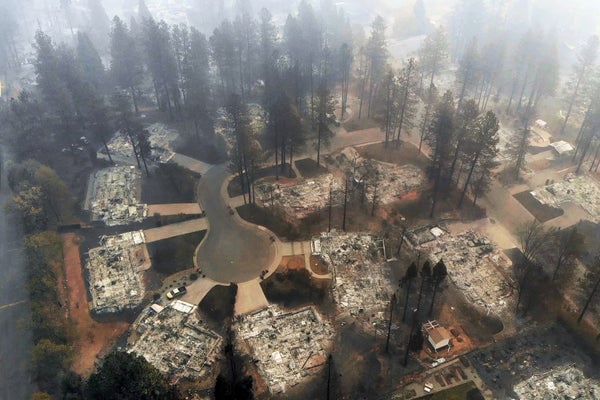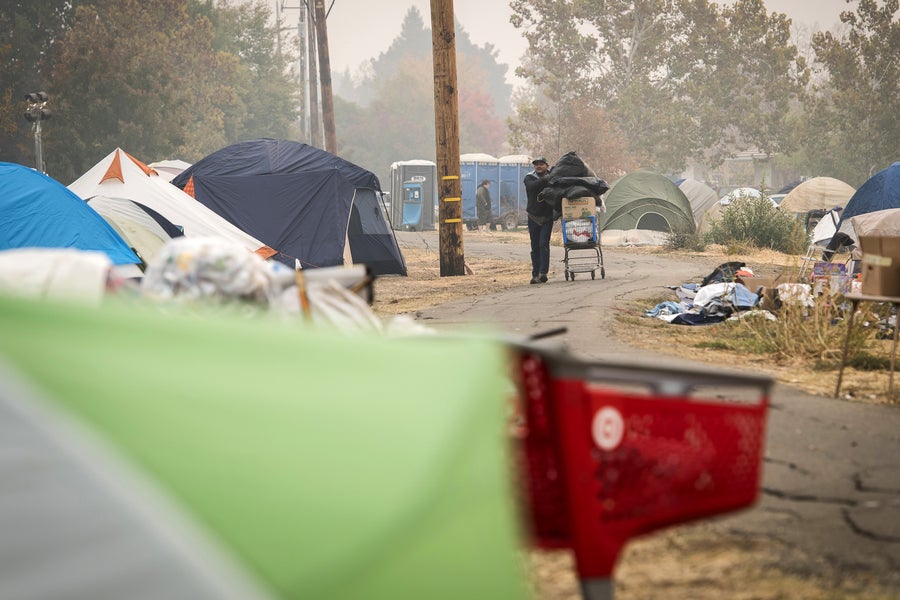Getting Rid of FEMA Will Bankrupt Small Towns
If the Trump administration successfully shutters FEMA, it will bankrupt small towns and force people to move

An aerial view of a neighborhood destroyed by the Camp Fire in Paradise, California on Nov. 15, 2018.
Carolyn Cole/Los Angeles Times via Getty Images
The Trump administration is preparing to eliminate the Federal Emergency Management Agency (FEMA), the agency that leads the nation’s disaster response. We predict this move will have the unintended consequence of bankrupting some small towns and accelerating the relocation of people out of high-risk areas. Cutting off the post-disaster financial assistance that FEMA provides to states will drive up taxes, drive down services, and drive out residents and small businesses. This “climate doom loop” poses the very real risk of destroying small-town America.
The number of billion-dollar disasters in the U.S. is increasing. A recent report says FEMA made a disaster declaration somewhere in the U.S. every four days, on average, in 2024. Disasters have displaced anywhere between one million and four million Americans per year in recent years; an estimated 20 percent of these people never return home. Some move in with family and friends, whereas others either cannot afford to return home or they have nothing left to lose by moving elsewhere in the search for a better life.
Then there are significant challenges for local governments associated with accommodating displaced households, whether individuals or families. They must extend resources to accommodate new students in schools and manage crowding-out pressures associated with rapid inflation in home prices and rents. From Chico, Calif., to Orlando, Fla., cities where people have relocated after disasters have faced significant pressures from the influx. After the 2018 Camp Fire all but destroyed the town of Paradise, Calif., 20,000 people moved to Chico. The sudden relocation caused a 21 percent spike in housing prices and triggered a homelessness surge that the city still struggles with seven years later. Disasters are not just local events.
On supporting science journalism
If you’re enjoying this article, consider supporting our award-winning journalism by subscribing. By purchasing a subscription you are helping to ensure the future of impactful stories about the discoveries and ideas shaping our world today.

A Camp Fire evacuee pushes a shopping cart with donated items in Chico, California, on Thursday, Nov. 15, 2018.
David Paul Morris/Bloomberg via Getty Images
Even California, with one of the largest economies in the world, cannot afford individual assistance grants that shelter and feed its own residents. The state most certainly cannot afford to replace the federal public assistance dollars that repair and replace the basic infrastructure for turning on the lights and flushing the toilets. Without FEMA’s financial support, state and local governments will be forced to borrow more money, increase taxes and even privatize public infrastructure. Many small towns will be forced to scale back critical services, including closing schools, libraries, parks and solid waste facilities, because they are limited in how much money they can borrow and how much they can tax residents.
Increased taxes and utility bills on top of skyrocketing insurance costs are already pushing people to move. The situation is so dire with natural disasters and spiraling insurance costs in Louisiana that Moody’s Investor Service is concerned that the ongoing and projected loss of working-age people represents a material credit risk for the state. Even wealthy states such as Florida face significant credit risks without FEMA’s financial assistance, particularly as tax rolls shrink with waning property values in high-risk counties. Florida is only a few catastrophic hurricanes away from an income tax, which would have a chilling impact on its population growth. Florida already experiences more deaths than births, and its future is entirely reliant on people moving to the Sunshine State.
Natural hazards and climate-attributed extreme events are wrecking havoc on communities and local economies across the Sun Belt. People initially moved there for warm weather, but the real reason for the region’s growth since the 1990s has been centered on the readily available supply of affordable housing. Recent research has even found evidence that some people are beginning to move away from the Sunbelt, particularly retirees and younger households who are rethinking where they want to plant their roots in the long term. These people are sensitive to the unexpected costs of disasters and insurance eating into their hard-earned wealth just as they are attempting to retire or build families. When people move, they take their tax revenue with them.
The cost of living will no doubt continue to increase in higher-risk areas across the Sunbelt and beyond, and without FEMA those costs will skyrocket. FEMA does not just help coordinate recovery. The agency also invests in risk-reduction infrastructure, and it sets rules that offer predictability and keep costs down for insurance policies and mortgages. FEMA also provides grants and affordable loans for infrastructure projects that keep schools safe and hospitals accessible for tens of millions of American households. Without FEMA, municipal bond and mortgage investors on Wall Street will decide who gets to rebuild and who gets left behind.
Those local governments that do begin the long process of rebuilding will still face the erosion of both their local population and their economy. The costs of debris removal, toxic cleanup and infrastructure recovery are so significant that one in five county governments impacted by disasters have to borrow money and implement public funding cuts while they wait for FEMA assistance. These events drain so much cash that even the City of Los Angeles faced a negative credit outlook from its credit rating agency after recent wildfires, meaning there was concern about the city’s ability to meet financial obligations.
For some small towns and counties, the only path forward might be to default on their debt and to file for bankruptcy. After the Camp Fire, Paradise’s redevelopment agency eventually defaulted on their debt in 2023. Research tells us that FEMA’s post-disaster aid plays a major role in preventing widespread bond defaults. By the same token, municipal bankruptcy after disasters is nothing new. Galveston, Tex., filed for bankruptcy after a major hurricane in 1900. Bankruptcy would have the perverse effect of driving up the cost of living and driving away residents and small businesses. Many small towns face the prospects of being wiped off the map—physically and economically.
The Trump administration and Congress should reform and invest in FEMA if they are serious about taming inflation, promoting working class households and shrinking government. They should invest in FEMA’s capacity to help preserve the communities and small towns that define the American experience. It is one thing to rename places on maps, but it is another to erase the places that people call home.
This is an opinion and analysis article, and the views expressed by the author or authors are not necessarily those of Scientific American.










